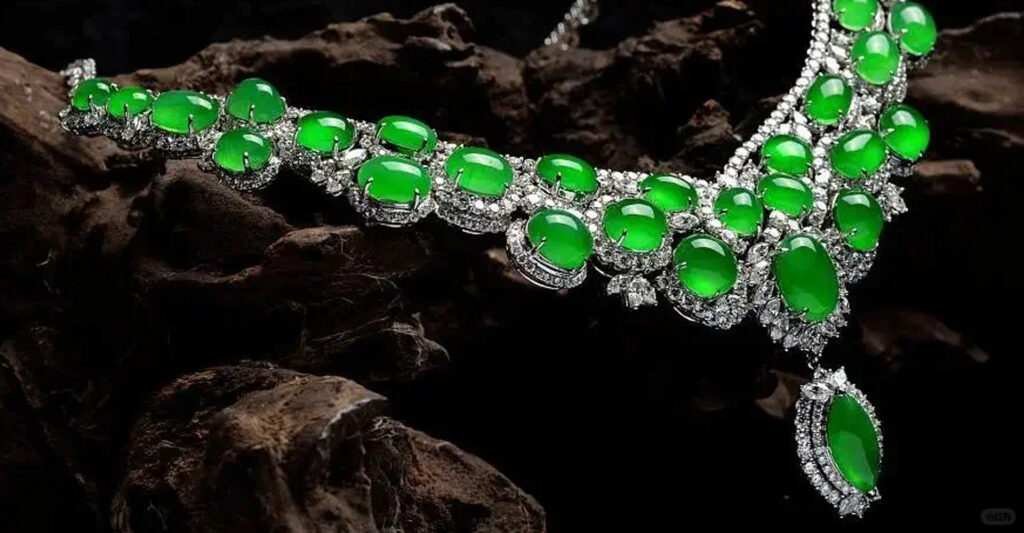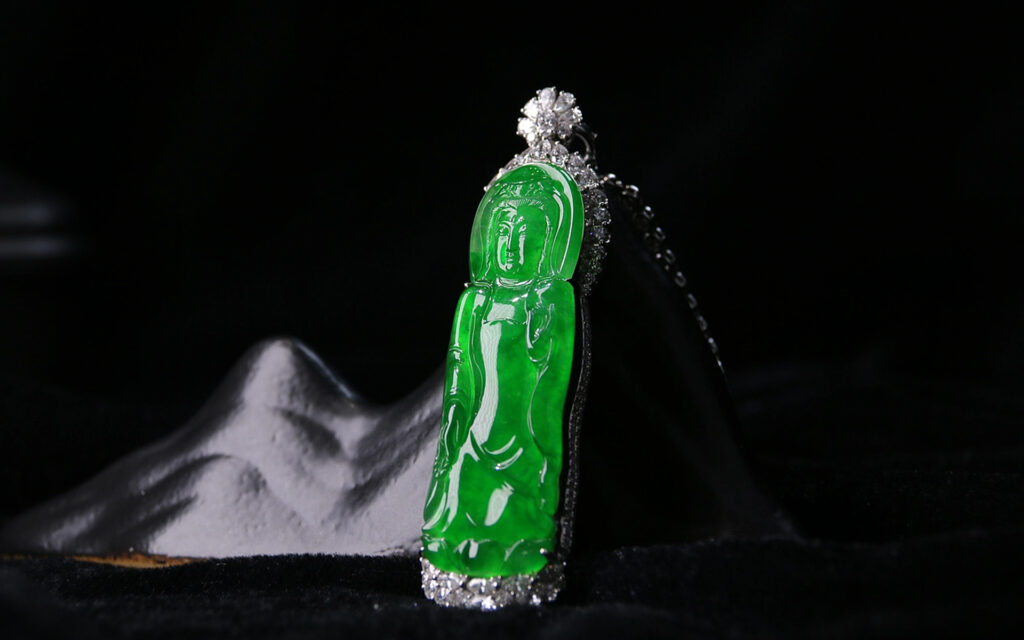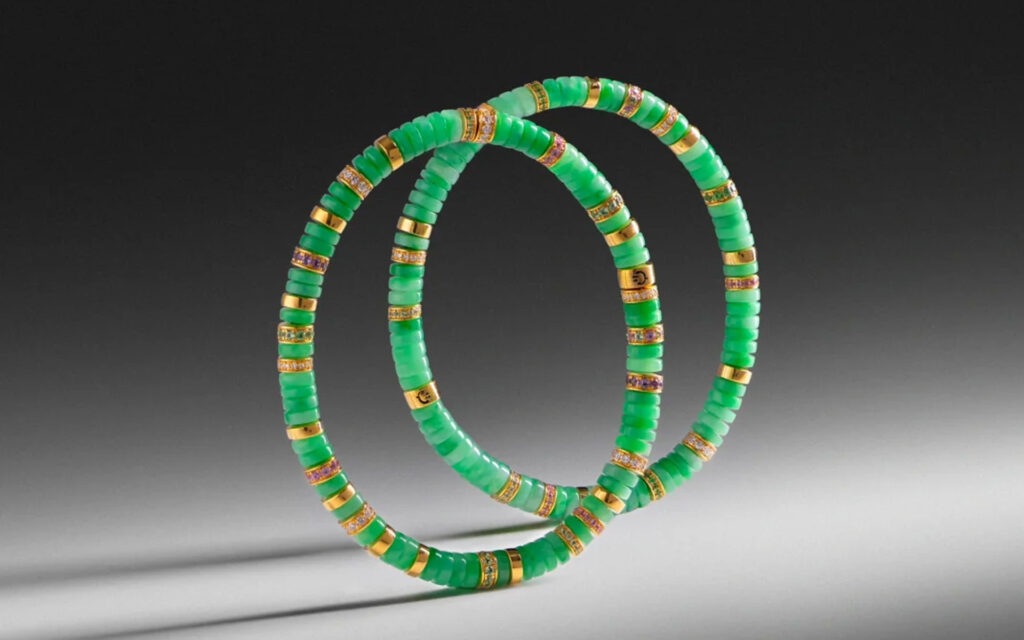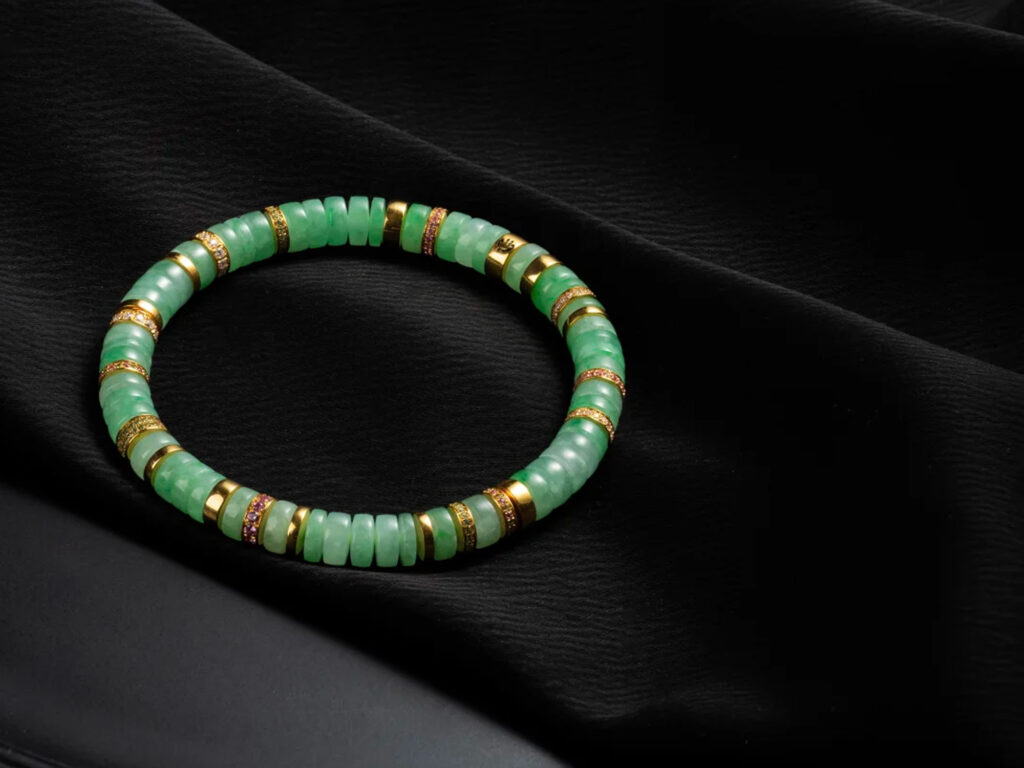As a symbol of Eastern jewelry culture, jadeite holds both market value and cultural significance. However, with the advancement of counterfeiting techniques, consumers face the risk of paying premium prices for fakes. So, how can one distinguish genuine jadeite from counterfeits? How to select a jadeite bracelet that truly resonates with you? Below, we’ll provide a detailed guide.

I. How to Distinguish Authentic Jadeite from Counterfeits?
Here comes some practical gem appraisal knowledge! Jadeite truly reigns supreme in the world of jade—quality pieces often command prices that leave buyers in awe! Sometimes when you find a bargain, you worry if it’s fake. Today, I’ll share five essential tips for authenticating jadeite—insights gained from years in the jewelry industry. With these five points, you’ll never have to worry again! Without further ado, let’s dive into the “One Weigh, Four Inspect” method.

1. Inspect the Surface: Orange Peel Effect vs. Acid-Etched Patterns
Examine the polished surface of natural jadeite. You’ll notice irregularly sized dimples and raised areas resembling orange peel—this is the distinctive orange peel effect unique to natural jadeite.
Some merchants use low-grade jadeite as raw material, first soaking it in strong acid to destroy its internal structure. This process aims to remove unsightly impurities within the jadeite, which are key factors determining its value.
They then fill the resulting voids and cracks with natural resin adhesive, creating a seemingly transparent and beautiful jadeite. BC-grade jadeite surfaces invariably display continuous pitting from this acid treatment. Due to varying dissolution rates of minerals within the acid-washed jadeite, a spiderweb-like pattern of unevenly sized pits and grooves typically forms.
2. Observe the Luster: Glassy or Oily
Genuine A-grade jadeite possesses a fine texture with a glass-like luster, featuring sharply defined light spot boundaries. Acid-treated BC jadeite, filled with low-refractive-index resin, exhibits a soft, oily sheen. Upon close inspection, its light spot boundaries appear distinctly blurred.
3. Observe color roots: Distinct direction or diffuse floating
Natural A-grade jadeite’s color roots resemble human arteries—clearly visible, with color gradually radiating outward along their path, revealing a distinct directional flow.
After acid washing removes impurities, BC jade appears clean, with its yellow base color replacing the previous grayish-brown impurities. However, the original green portions remain, appearing exceptionally vivid and pure. The color edges often appear diffuse and float like spiderwebs, with color roots either invisible or indistinct.
4. Observing Fluorescence: Natural Color or White-Purple
Natural jadeite shows no change under a 360nm UV light, retaining its original color, as it does not react to ultraviolet radiation.
However, due to surface protective wax, especially in grooves, a slight fluorescent reaction is normal. BC-grade jadeite, treated with acid washing and resin filling, exhibits blue-white or blue-purple fluorescence under UV light. This color reflects the light from the organic resin fillers.
5. Weight: Heavy or Light
A-grade natural jadeite has high density and feels substantial in the hand.
BC jadeite, having undergone artificial corrosion and resin filling, has its internal structure compromised, naturally reducing its density and making it feel lighter in hand.
Sellers do this purely for profit. Some jade enthusiasts mistakenly believe they’ve found a bargain, thinking they’ve purchased high-grade jadeite at a low price. Therefore, learning to distinguish genuine from fake jadeite is essential.

II. How to Select a Jadeite Bracelet That Suits Your Taste?
Among jadeite products, common styles include rings, bracelets, bracelets, pendants, and decorative pieces. However, knowledge about jadeite bracelets is not widely understood, leaving many people confused about how to make a cost-effective choice when purchasing. Some even believe that an exceptional jadeite bracelet can significantly enhance personal charm. So how does one choose the right jadeite bracelet? Today we’ll explain the selection process.

1. Color of Jadeite Bracelets
When selecting a jadeite bracelet, start by examining its color. Look for purity, vibrancy, and uniformity. Use a spotlight flashlight to check for hidden discoloration. Jadeite with rich, pure, and evenly distributed color typically indicates higher quality.
The beads of a jadeite bracelet should exhibit consistent coloration and orderly distribution. Otherwise, it will appear aesthetically lacking, negatively impacting both appearance and value. If each bead displays multiple shades, the bracelet’s value will significantly increase, often to surprising levels. A good jadeite bracelet features pure, bright colors; the higher the saturation, the greater its value. Among these, green jadeite bracelets are the most common and popular on the market.
Since natural jadeite colors typically appear in blocky, speckled, or thread-like patterns, a bracelet with color evenly distributed throughout commands higher market value, classifying it as premium jadeite. Emerald green jadeite holds the highest value, followed by red and purple. Among greens, the most prized is a fresh, tender shade with a slight yellow undertone, known as “seedling green.” This is followed by emerald green, river water green, and oily green, with even distribution being the most desirable.
2. Jadeite Bracelet Beads
Generally, jadeite bracelet beads come in different diameters, suited for different wearers. Take 12mm beads as an example: such bracelets suit slender men or women with wider wrists. They appear neither overly conspicuous nor subtly enhance the wearer’s elegance. However, most men are better suited to 14mm jade bracelets, which are also more common in the market.
3. Jadeite Bracelet Water Quality
Within the jadeite industry, the texture and water quality of jadeite are collectively referred to as “jadeite’s texture and water.” Texture refers to the coarseness or fineness of the jadeite’s grain, while water quality denotes its transparency. Since jade’s “quality and water” is synonymous with the texture’s excellence and a key factor determining its price, examining this aspect should be the first step when selecting a jade bracelet.
Water quality significantly impacts a jade bracelet, being closely tied to transparency. It is often described using the term “fenshui” (水头). The longer the water quality, the more pleasing the bracelet appears. Thus, a piece of jewelry relying solely on color without sufficient water quality is inadequate. One can also assess a jadeite bracelet’s transparency under strong light; higher transparency indicates superior quality. Additionally, examine the craftsmanship—some pieces may have cracks, so prioritize those with smooth surfaces, excellent polish, and well-proportioned shapes.
4. Jadeite Bracelet Quality
Quality and translucency are often discussed together. Only when both are present does the bracelet achieve exceptional overall appearance and unique charm. Higher quality and translucency increase value, and each bead should be uniform. Additionally, examine the craftsmanship: assess whether the beads are perfectly round, as irregularly shaped beads diminish value. Check for scratches, as numerous marks significantly reduce worth. Ensure uniform size, as a strand with mixed-sized beads also impacts value.
5. Jadeite Bracelet Design
Currently, jadeite bracelets on the market primarily fall into two design categories. One features various themes, where jadeite beads are carved into distinct shapes to form the bracelet. This style boasts intricate carving and ingenious design. The other style employs plain carving, resulting in simpler, more elegant forms.
In reality, jadeite bracelet beads also demand higher standards for the size of the jadeite material. After all, larger dimensions require beads with greater diameter or a higher quantity.
Appraising jadeite is a discipline that blends scientific testing with artistic appreciation. For ordinary consumers, it is advisable to follow the principle of “look, ask, and compare”: first observe the characteristics of genuine pieces through channels like museums and auctions, then consult authoritative appraisers, and finally compare products from different retailers. Remember, natural jadeite is a miracle nurtured by nature over millions of years. Its value lies not only in the material itself but also in cultural heritage and emotional significance.